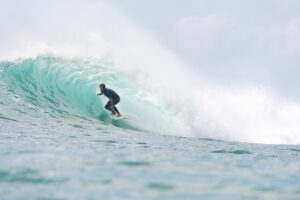
Before we get into the steps of standing up, let’s address a frequently asked question about this technique:
Should you try to carry one foot after the other or try to land both feet on the board at the same time?
Looking at hundreds of analyses, we have noticed that most advanced surfers, including pros, bring their back foot first and then their front foot to the board. They do it so fast that unless you’re watching slow-motion video, it looks like they’re carrying both feet at the same time. We recommend focusing on bringing your back foot first and then your front foot to the board.
We often see beginner and intermediate surfers fall over when trying to get both feet on the board at the same time. This is mainly because they lack the experience to get both feet into the correct place on the board at the same time. By bringing one foot after the other, surfers have a little more time to position their feet and make sure they are balanced before standing up. Also, bringing your back foot in first helps you create more room to bring your front foot to the board between your hands.
You can compare both options at home. Lie on your stomach and see which is more physically demanding for you: whether to sit up with your back foot first or bring both feet into the correct position simultaneously, with your front foot landing roughly between your hands and your front knee coming under your chin. Rarely do we find students more comfortable wearing both feet at the same time, but if this is your thing, you may want to consider trying it out of the water.
FIRST STEP:
The first step for this technique is to drive your upper body up, swinging your knees forward and landing on your back foot. This may sound like several steps, but it needs to be done in one fluid motion. To test if you can do this step, lie on your stomach with your hands under your pecs, lift your upper body as your thighs come off the floor, and see if you can swing both knees up and forward without dragging on the floor. , and land with your back foot towards where the tail of the board would be.
Frequently, surfers land first with their toes on the tail of the board, which is fine. Be sure to swing your knees up and forward using only your hands and knees as points of contact with the ground or board. You can lift your feet off the ground before
undertaking the pop-up to avoid using your toes. We often see surfers practicing this technique on land, using their toes as a contact point on the ground, which is easier if you’re riding a shortboard or fishboard. However, you should avoid practicing this way in the water, as your feet will be hanging farther back on the board and you won’t be able to place your toes on the board to propel yourself off.
SECOND STEP:
The next step is to push your body up to create more space. Once you’re in this pushup-like position, the rest of the process is similar to other pop-up techniques, like the chicken wing. You want to drive your whole body up and over the board, creating the necessary space between your body and the board for the next step: bringing your front foot forward.
THIRD STEP:
The last step is to bring your front foot up and stand up. Draw your front knee forward toward your chest and place your front foot on the board. Notice how the knee slides close to the surface of the chest during this step. Your front foot should land straight on the stringer of the board, between your hands. Remember to look where you want to go during the pop-up and use your hands for speed and balance.
This tutorial was divided into multiple steps in order to clarify the body movements during the pop-up. In reality, however, the standard standing up is done quickly, in one fluid motion, with no pauses between steps. Surfers do not pause between these steps as they have been automated through practice.
The good thing about pop-up is that it is one of the few things in surfing that can be practiced almost anywhere and at any time.





